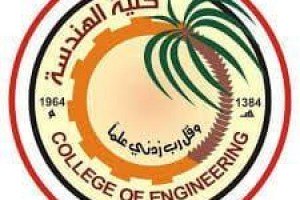
The doctoral thesis of the student Hala Karim Kazim was discussed in the College of Engineering, University of Basra, Department of Civil Engineering, entitled The effect of soil interaction with the infrastructure on the seismic response of buildings. The thesis includes The soil samples were taken from two locations approximately 6 km (silty sand soil) and 20 km (silty clay soil) south of Al-Amarah city in southeast Iraq. Five steel samples and five concrete samples with varying surface roughness were included in this investigation. Utilizing a Digital Surface Roughness Tester (SRT-6210). A modified direct shear box device was designed to determine the interface shear strength parameters.
The results showed that higher surface roughness greatly improves the adhesion at interfaces, for steel-clay and concrete-clay by 32% and 26.24% respectively. The friction angle for both steel-clay and concrete-clay interfaces increased with surface roughness by about 37.95% and 36.3%, respectively.
Furthermore, the interface friction angle increased by 45.95% with the increase of roughness for the sand-steel interface and by about 27.45% for the interface between concrete samples and sandy soil. These results are essential for the design of foundations and other structural components, especially in regions where soil conditions are of great importance, such as areas susceptible to seismic activity.
The second part examines the impact of soil-structure interaction (SSI) and interface componentry on the seismic behavior of structures. Quantitative simulation is conducted using the well-known software, ABAQUS. In this part, three comprehensive case studies were examined. The first case study inspects a six-story structure supported by a piled-raft foundation, while the second case focuses on a three-story structure supported by a raft foundation. Both cases utilize the Mohr-Coulomb Model (MCM) and the Cam Clay Model (CCM) to simulate the behavior of silty clay soil. The third case study focusses on an eight-story concrete structure situated in the Buzergan oil field within the Maysan governorate. The Mohr-Coulomb Model (MCM) is used to model the silty sand soil at this site. Both free and forced vibration scenarios are taken into account in the analyses. Conducting free vibration analysis enables the identification of the natural frequencies and mode shapes of buildings. The results indicate that the inclusion of interface components typically reduces the natural frequencies by about (37.34-
80.92%) in comparison to a fixed base scenario. On the other hand, forced vibration analysis models the responses of buildings to seismic events, particularly the Ali-Algharbi earthquake. Including an interface result in higher lateral displacement, axail force, shear force and bending moments by about : (1.7-46)%, (10-24%), (14-54.7%) and (12.8-36%) respectively, during seismic events. The inclusion of an interface element in the soil-structure interaction model significantly increases lateral pile displacement not more than 26%, bending moments by about 21%, and shear forces by about 20% compared to models without it .








